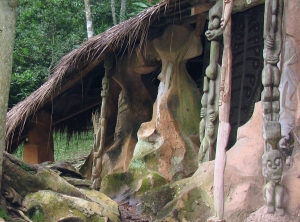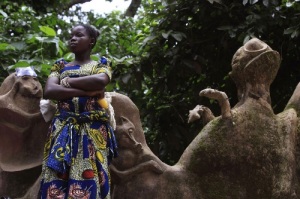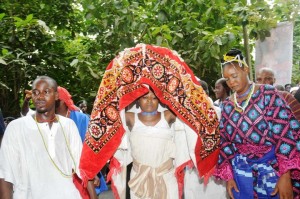Although many African traditions have been wiped out by globalism and modernization, the Osun Osogbo festival is one of the aspects of African cultural heritage that continues to this day. Last Friday, the Osun Osogbo festival culminated with thousands of people all over the world coming together in celebration.The two-week long festival is held every year in honour of the river Goddess Osun and Her relation to King Larooye, the founder of the Osun community. Some describe Her as the spirit queen of Osogbo, Oso-igbo, and She is considered the Spiritual Mother of all the succeeding kings of Osogbo. Osun is considered as a Goddess of fertility, protection, and blessing. She is also attributed with healing the sick with Her healing river waters.
 The history of Osogbo and the festival can be traced to 1670. At this time, a hunter named Olutimilehin came across a dam during one of his hunting trips. Due to the scarcity of water that his people were suffering from, he investigated to see if the dam was capable of supporting people. Unfortunatley, the dam did not have a sufficient water supply, but during Olutimilehin’s investigation of the dam he came across a stream named Okrokro, which he followed to its larger source from the River Osun. The hunter returned back to his community to inform the king, Larooye Gbadewolu, about the abundant water source. The king and his subjects moved to the flood plain that Olutimilehin had described and built his first palace, later known as Ile Osun. One day as the king Larooye and his subjects were clearing brush to cultivate the land, they accidentally cut down a tree that landed in the river. The Goddess Osun cried out. The people then later moved to the upper terrace in the plain which they later named Oke Ohuntoto at the present day Osun Grove. The Osun Grove was later abandoned as the community grew and the people moved to Ode-Osogbo.
The history of Osogbo and the festival can be traced to 1670. At this time, a hunter named Olutimilehin came across a dam during one of his hunting trips. Due to the scarcity of water that his people were suffering from, he investigated to see if the dam was capable of supporting people. Unfortunatley, the dam did not have a sufficient water supply, but during Olutimilehin’s investigation of the dam he came across a stream named Okrokro, which he followed to its larger source from the River Osun. The hunter returned back to his community to inform the king, Larooye Gbadewolu, about the abundant water source. The king and his subjects moved to the flood plain that Olutimilehin had described and built his first palace, later known as Ile Osun. One day as the king Larooye and his subjects were clearing brush to cultivate the land, they accidentally cut down a tree that landed in the river. The Goddess Osun cried out. The people then later moved to the upper terrace in the plain which they later named Oke Ohuntoto at the present day Osun Grove. The Osun Grove was later abandoned as the community grew and the people moved to Ode-Osogbo.
 Over the centuries, the Osun Grove continued to be held as sacred to the Yoruba people of Osogbo, but from the time that Islam and Christianity were brought into the area during the mid-1800s, it gradually became less and less fashionable to be associated with the traditional Yoruba religion. By the 1950’s, customary responsibilities were weakening, shrines were neglected, statues were looted, and traditional priests abandoned their positions. The Department of Agriculture acquired the Osun Grove at this time, establishing teak plantations and felling numerous trees on the site. It was at this time that Austrian-native Suzanne Wenger moved to Osogbo, who with the encouragement of the priests and local people formed the New Sacred Art Movement to counter land speculators, repel poachers, and protect traditional shrines in the area. Artists who participated in the New Sacred Art Movement created large, heavy sculptures out of iron, cement, and mud as opposed to the smaller traditional statues made of wood. This was done in order to prevent theft of the sculptures. In 1965, part of the Grove received protection as a national monument and this protection was expanded to include the entire Grove in 1992. The Osun Grove was recognize as a World Heritage Site by UNESCO in 2005. According to UNESCO:
Over the centuries, the Osun Grove continued to be held as sacred to the Yoruba people of Osogbo, but from the time that Islam and Christianity were brought into the area during the mid-1800s, it gradually became less and less fashionable to be associated with the traditional Yoruba religion. By the 1950’s, customary responsibilities were weakening, shrines were neglected, statues were looted, and traditional priests abandoned their positions. The Department of Agriculture acquired the Osun Grove at this time, establishing teak plantations and felling numerous trees on the site. It was at this time that Austrian-native Suzanne Wenger moved to Osogbo, who with the encouragement of the priests and local people formed the New Sacred Art Movement to counter land speculators, repel poachers, and protect traditional shrines in the area. Artists who participated in the New Sacred Art Movement created large, heavy sculptures out of iron, cement, and mud as opposed to the smaller traditional statues made of wood. This was done in order to prevent theft of the sculptures. In 1965, part of the Grove received protection as a national monument and this protection was expanded to include the entire Grove in 1992. The Osun Grove was recognize as a World Heritage Site by UNESCO in 2005. According to UNESCO:
“The Osun Sacred Grove is the largest and perhaps the only remaining example of a once widespread phenomenon that used to characterise every Yoruba settlement. It now represents Yoruba sacred groves and their reflection of Yoruba cosmology. It is a tangible expression of Yoruba divinatory and cosmological systems; its annual festival is a living thriving and evolving response to Yoruba beliefs in the bond between people, their ruler and the Osun goddess.”
 Events of the Osun Osogba festival include cultural dances by the Osun State Cultural Troupe, special blessings by the priests, drawing water for spiritual healing, and displays of traditional dresses. Nigerian Voice Magazine describes the festivities and activities as:
Events of the Osun Osogba festival include cultural dances by the Osun State Cultural Troupe, special blessings by the priests, drawing water for spiritual healing, and displays of traditional dresses. Nigerian Voice Magazine describes the festivities and activities as:
“Osun Osogbo Festival has a two-week programme of events starting with the traditional cleansing of the town called Iwopopo, followed by the lighting of the 500 years old 16 points lamp three days later, called Olojumerindinlogun. This is followed by Iboriade some four days later, which is the assemblage of all the crowns of the past rulers (Ataojas), for blessings. The festival’s grand finale showcases the cultural procession of the people to the Osun Groove. As a mark of respect to the Osun deity, the people visit the grove to pay homage to what is now known as the living spring.”
At this year’s Osun Osogba, the new arugba (votary maid) was the main attraction at the festival. The arugba is a virgin dedicated to the riven Goddess Osun until she decides to get settled down. At the Osun Osogbo Festival, she carries the heavy calabash filled with sacrificial items on top of her head. The former arugba had performed her cultural role for the past ten years before deciding to retire and get married.
 An informative video presentation of the festival may be watched at the link below:
An informative video presentation of the festival may be watched at the link below:
References:
http://www.osundefender.org/?p=118151
http://whc.unesco.org/en/list/1118
